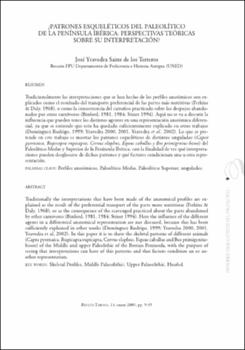¿Patrones esqueléticos del paleolítico en la Península Iberica: perspectivas teóricas sobre su interpretación?
Date
2004Abstract
Tradicionalmente las interpretaciones que se han hecho de los perfiles anatómicos son explicados
como el resultado del transporte preferencial de las partes más nutritivas (Perkins
& Daly, 1968), o como la consecuencia del carroñeo practicado sobre los despojos abandonados
por otros carnívoros (Binford, 1981, 1984; Stiner 1994). Aquí no se va a discutir la
influencia que pueden tener los distintos agentes en una representación anatómica diferencial,
ya que se entiende que esto ha quedado suficientemente explicado en otros trabajos
(Domínguez Rodrigo, 1999; Yravedra 2000, 2001, Yravedra et al., 2002). Lo que se pretende
en este trabajo es mostrar los patrones esqueléticos de distintos ungulados (Capra
pyrenaica, Rupicapra rupicapra, Cervus elaphus, Equus caballus y Bos primigenius-bison) del
Paleolítico Medio y Superior de la Península Ibérica, con la finalidad de ver qué interpretaciones
pueden desglosarse de dichos patrones y qué factores condicionan una u otra representación. Traditionally the interpretations that have been made of the anatomical profiles are explained
as the result of the preferential transport of the parts more nutritious (Perkins &
Daly, 1968), or as the consequence of the scavenged practiced about the parts abandoned
by other carnivores (Binford, 1981, 1984; Stiner 1994). Here the influence of the different
agents in a differential anatomical representation are not discused, because this has been
sufficiently explained in other works (Domínguez Rodrigo, 1999; Yravedra 2000, 2001,
Yravedra et al, 2002). In this paper it is to show the skeletal patterns of different animals
(Capra pyrenaica, Rupicapra rupicapra, Cervus elaphus, Equus caballus and Bos primigeniusbison)
of the Middle and upper Paleolithic of the Iberian Peninsula, with the purpose of
seeing that interpretations can have of this patterns and that factors condition an or another
representation.





